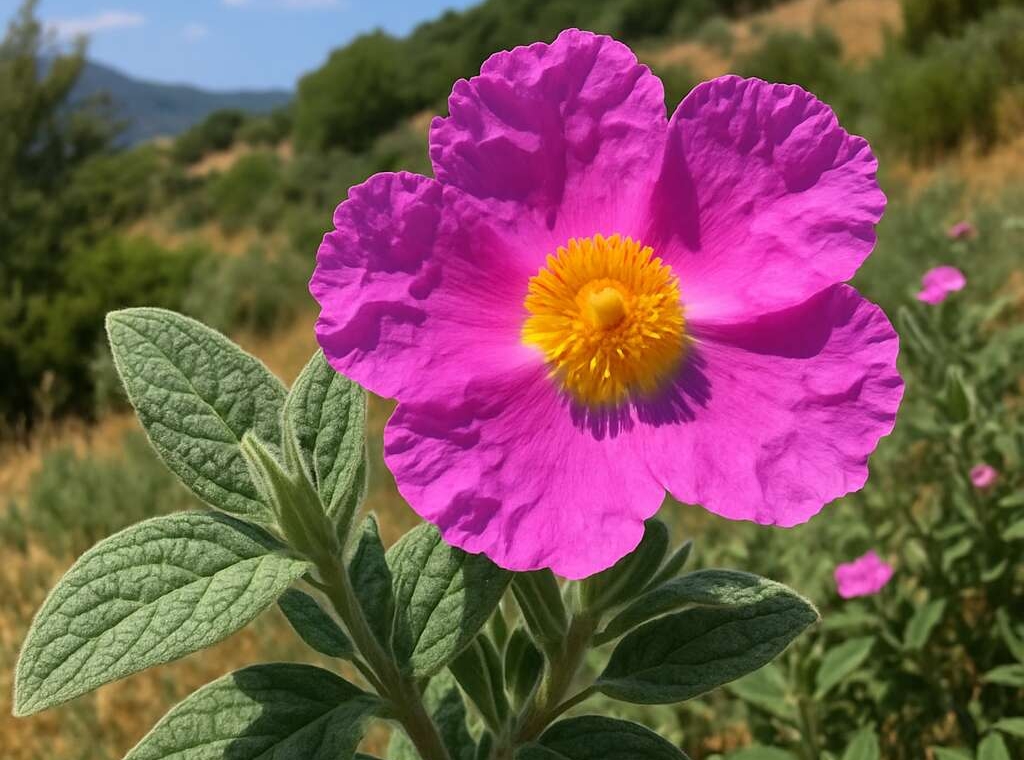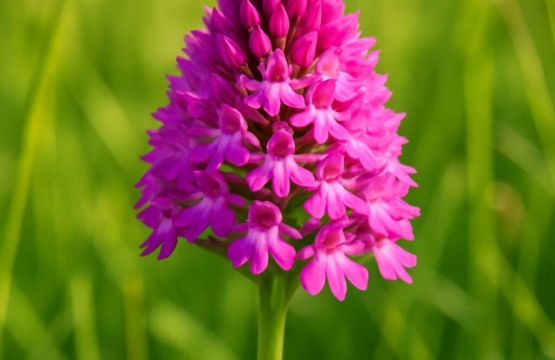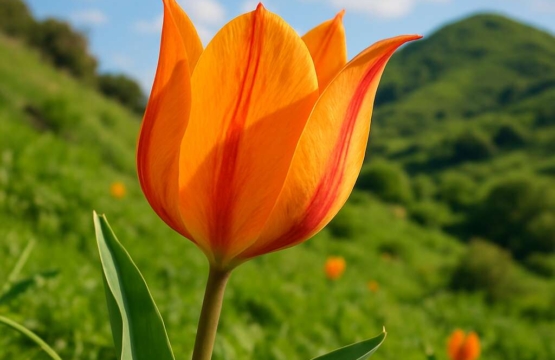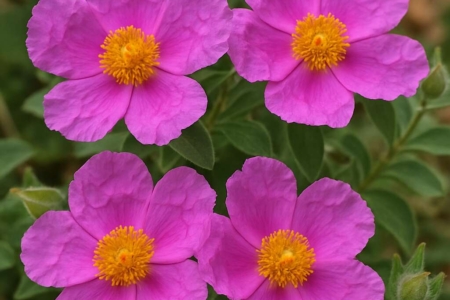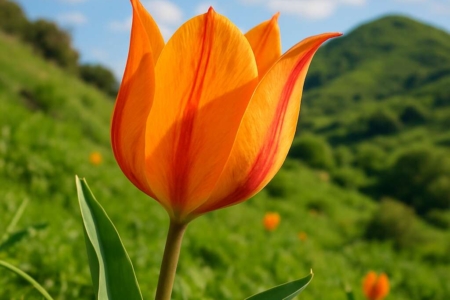Understanding Sage-leaved Cistus (Cistus salviifolius)
What is Sage-leaved Cistus? – Overview of Cistus salviifolius, including its botanical classification and origin
Sage-leaved Cistus (Cistus salviifolius) is a resilient shrub that thrives in the rocky terrains of Cyprus. Known for its aromatic, sage-like leaves, this plant belongs to the Cistaceae family, which includes many hardy Mediterranean species. Its origins trace back to the sun-drenched regions of Southern Europe and North Africa, where it has adapted to withstand arid conditions with ease.
Typically, Sage-leaved Cistus Cistus salviifolius displays sprawling branches covered in pale, crinkled leaves. During spring, it produces clusters of delicate, papery flowers in shades of white or pink, emanating a pleasant scent that attracts pollinators. Its ability to flourish in poor soils makes it a popular choice for landscaping in Cyprus, adding both aesthetic appeal and ecological value.
- Native to the Mediterranean basin
- Well-adapted to dry, rocky environments
- Valuable for its aromatic foliage and attractive flowers
Physical Characteristics – Description of the plant’s size, leaves, flowers, and overall appearance
Sage-leaved Cistus (Cistus salviifolius) is a striking example of resilience, with its physical characteristics perfectly adapted to the rugged landscapes of Cyprus. This shrub typically reaches heights of up to 1.5 meters, spreading out with sprawling, bushy branches that create a dense, almost wild appearance. Its leaves are a distinctive feature—pale green with a crinkled, sage-like texture that exudes a subtle aromatic scent, adding to its charm.
The flowers of Sage-leaved Cistus Cistus salviifolius are delicate yet captivating. During spring, clusters of papery blossoms emerge, often in shades of white or soft pink, each emitting a gentle fragrance that beckons pollinators. These blooms are fleeting but abundant, covering the shrub like a soft cloud and transforming arid terrains into a tapestry of color and scent. The overall appearance of this plant is both elegant and hardy, embodying the perseverance of Mediterranean flora.
- Height: Up to 1.5 meters
- Leaves: Pale green, crinkled, aromatic
- Flowers: White or pink, papery texture, fragrant
Its unique combination of size, foliage, and floral display makes Sage-leaved Cistus Cistus salviifolius a beloved subject for landscaping and ecological projects across Cyprus. The plant’s ability to thrive in poor, rocky soils underscores its role as a symbol of resilience and natural beauty in Mediterranean environments.
Natural Habitat and Distribution – Regions where the plant naturally occurs and preferred growing conditions
In the rugged terrains of Cyprus, where the sun kisses the earth with relentless devotion, Sage-leaved Cistus Cistus salviifolius finds its natural sanctuary. This resilient shrub has carved out a niche in the Mediterranean’s diverse landscape, thriving amidst rocky slopes and arid soils that seem inhospitable to most plant life. Its ability to flourish in these challenging conditions speaks volumes about its adaptability and hardy nature.
Native to the Mediterranean basin, Sage-leaved Cistus Cistus salviifolius is often seen dotting the landscape of Cyprus, where it contributes to the region’s ecological tapestry. Its preferred growing conditions include well-drained, rocky soils and full sun exposure, which amplify its aromatic foliage and delicate blossoms. These plants are remarkably drought-tolerant, making them an ideal choice for xeriscaping and ecological restoration projects across the island.
- Dry, rocky terrains
- Full sun exposure
- Well-drained soils
Understanding the distribution of Sage-leaved Cistus Cistus salviifolius reveals a plant that is both a symbol of resilience and an integral part of the Mediterranean flora. Its widespread presence across Cyprus underscores the plant’s ability to adapt and thrive in environments where few others dare to grow. Whether seen on the outskirts of villages or climbing along hillside contours, Sage-leaved Cistus Cistus salviifolius embodies the enduring spirit of the landscape it calls home.
Cultivation and Growing Tips for Cistus salviifolius
Soil Requirements – Ideal soil types and pH levels for optimal growth
When cultivating Sage-leaved Cistus Cistus salviifolius, understanding its soil preferences is essential for thriving growth, especially in the Mediterranean climate of Cyprus. This resilient shrub flourishes in well-drained soils that mimic its natural habitat—rocky, sandy terrains that drain efficiently are ideal. The plant prefers slightly alkaline to neutral pH levels, typically ranging from 7.0 to 8.0, which supports its robust root system and vibrant flowering. Poorly drained or overly acidic soils can hinder its development, leading to root rot or diminished flowering potential.
To optimize growth, consider soil amendments that improve drainage and provide calcium-rich content, aligning with the plant’s natural environment. For gardeners aiming to cultivate Sage-leaved Cistus Cistus salviifolius successfully, a layered approach—such as adding coarse sand or gravel—can mimic its native rocky terrain. This attention to soil conditions not only ensures a healthy display of blooms but also sustains the plant’s resilience against the harsh summer sun that characterizes its natural setting. Truly, matching the soil’s composition to the plant’s innate preferences unlocks the secret to vibrant, enduring growth.
Sunlight and Climate – Light exposure needs and temperature considerations
In the sun-drenched landscapes of Cyprus, where the Mediterranean breeze whispers through rocky terrains, Sage-leaved Cistus Cistus salviifolius emerges as a resilient symbol of natural beauty. To thrive amidst these conditions, understanding its sunlight and climate needs is paramount. This hardy shrub demands full sun exposure—ideally, at least six hours of direct sunlight each day—to produce its signature vibrant blooms and lush foliage. Its natural habitat, characterized by scorching summers and mild winters, equips Sage-leaved Cistus Cistus salviifolius with an extraordinary tolerance to heat and drought.
While it flourishes in warm climates, temperature considerations remain crucial. The plant tolerates high summer temperatures with ease but prefers protection from frost during the colder months. For optimal growth, gardeners in Cyprus should ensure that the plant is positioned in an area shielded from harsh winter winds and frost pockets. Incorporating elements such as:
- well-drained rocky soil
- ample sunlight
- protection from extreme cold
will create an ideal environment for Sage-leaved Cistus Cistus salviifolius to flourish. Its ability to adapt to these climate conditions makes it an exceptional choice for those seeking a low-maintenance yet striking addition to Mediterranean gardens.
Watering and Maintenance – Watering frequency, pruning tips, and care routines
Growing Sage-leaved Cistus Cistus salviifolius is as much an art as it is a science—requiring a delicate balance of watering, pruning, and attentive care routines. Contrary to its rugged appearance, this resilient shrub demands a watering schedule that respects its drought-tolerant nature. Typically, a deep soak every two to three weeks during the hot summer months suffices, especially if the soil is well-drained. Overwatering can quickly turn this Mediterranean beauty into a soggy disappointment, so patience and moderation are key.
Pruning Sage-leaved Cistus Cistus salviifolius is equally essential for maintaining its vigorous, bushy form. A gentle trim after flowering encourages new growth and promotes an abundance of vibrant blooms. Remember, this plant appreciates a light hand—think of it as giving it a stylish haircut rather than a harsh shave. For best results, prune to remove spent flowers and any leggy stems, which keeps the plant looking its most pristine and resilient.
Care routines should also include periodic checks for pests and diseases—though hardy, Sage-leaved Cistus Cistus salviifolius benefits from a clean and tidy environment. Incorporating organic mulch around the base can help conserve moisture and suppress weeds, but be cautious not to bury the crown.
- Ensure soil remains well-drained
- Apply a light layer of mulch annually
- Prune lightly after flowering
These simple steps will keep your Mediterranean garden thriving, showcasing the rugged charm of Sage-leaved Cistus Cistus salviifolius in its full glory.
Propagation Methods – Seed sowing, cuttings, and other propagation techniques
Propagating Sage-leaved Cistus Cistus salviifolius offers a rewarding journey into cultivating this resilient Mediterranean shrub. While seed sowing is a straightforward method, it requires patience and an eye for detail. Begin by collecting mature seeds from healthy plants during late summer or early autumn. Sow the seeds in well-draining, slightly alkaline soil, pressing them lightly into the surface without covering too deeply. Keep the soil moist but not waterlogged, maintaining a gentle warmth to encourage germination.
Alternatively, cuttings provide a faster route to establishing new plants. Take semi-hardwood cuttings in late spring or early summer, ideally around 10-15 centimeters long. Remove the lower leaves and dip the cut end into rooting hormone—this step boosts success rates significantly. Insert the cutting into a pot filled with sandy, well-drained medium, then place it in a sheltered spot with indirect sunlight. Regular watering and maintaining humidity around the cutting will promote healthy root development.
For those seeking an efficient approach, layering or division can also be effective, especially for mature Sage-leaved Cistus Cistus salviifolius specimens. No matter which propagation method you choose, patience is essential, but the effort will reward you with a flourishing, drought-tolerant shrub that embodies the rugged charm of the Mediterranean landscape.
Health and Medicinal Uses of Sage-leaved Cistus
Traditional Uses – Historical and cultural medicinal applications
Throughout history, Sage-leaved Cistus Cistus salviifolius has been revered not only for its striking appearance but also for its profound medicinal properties. In ancient Cyprus and surrounding Mediterranean cultures, this resilient shrub was woven into traditional healing practices, often regarded as a botanical talisman against ailments. Its aromatic leaves, imbued with natural compounds, were used to brew infusions believed to cleanse the body and restore vitality. The plant’s rich history as a medicinal herb offers a glimpse into a time when nature’s pharmacy was revered as sacred.
Traditional uses of Sage-leaved Cistus Cistus salviifolius extend beyond simple remedies; it was often employed in rituals and holistic treatments. Indigenous communities utilized its leaves and extracts to prepare poultices for wounds, harnessing its antiseptic qualities. Some cultures even believed that inhaling its fragrant smoke could purify the soul and ward off evil spirits. Today, modern herbalists continue to explore the plant’s medicinal potential, appreciating its enduring legacy rooted in centuries of cultural reverence.
Modern Research – Scientific studies on the health benefits and active compounds
Modern scientific research continues to unveil the remarkable health benefits of Sage-leaved Cistus Cistus salviifolius, a plant long revered for its medicinal virtues. Rich in natural compounds such as polyphenols and flavonoids, this resilient shrub exhibits potent antioxidant and anti-inflammatory properties that are now catching the attention of herbal enthusiasts and health practitioners alike.
Studies have demonstrated that extracts from Sage-leaved Cistus Cistus salviifolius can support immune function, aid in tissue healing, and combat oxidative stress. Its natural antiseptic qualities have also been confirmed through laboratory analysis, validating traditional uses for wound healing and infection prevention. In addition, its aromatic leaves contain compounds that may help reduce inflammation and promote respiratory health.
In recent years, researchers have identified specific active compounds like gallic acid and ellagic acid within Sage-leaved Cistus Cistus salviifolius, which contribute to its therapeutic potential. These findings suggest that incorporating this plant into herbal formulations could enhance overall wellness and resilience. As interest in natural remedies grows, Sage-leaved Cistus Cistus salviifolius stands out as a botanical treasure with scientifically backed health benefits.
Precautions and Safety – Potential side effects and usage guidelines
Sage-leaved Cistus Cistus salviifolius, a resilient shrub rooted in the Mediterranean’s rugged landscape, has long been celebrated for its therapeutic potential. Yet, as with all potent botanicals, caution must accompany its use. While its natural compounds—such as polyphenols and flavonoids—offer impressive health benefits, improper application or overuse can lead to unwanted side effects.
Potential side effects of Sage-leaved Cistus Cistus salviifolius include allergic reactions, especially in sensitive individuals. Symptoms may range from skin irritation to respiratory discomfort. It is essential to adhere to recommended dosages and avoid high concentrations unless guided by a qualified herbalist or healthcare provider. Pregnant and nursing women should exercise particular caution, as safety data is limited in these populations.
When incorporating Sage-leaved Cistus Cistus salviifolius into herbal remedies, start with small doses and monitor your body’s response. If adverse reactions occur, discontinue use immediately and seek medical advice. Always opt for high-quality extracts or dried leaves from reputable sources to ensure safety and efficacy. Remember, even the most potent plants demand respect and mindful application—wisdom must guide their use to harness their healing virtues without risking harm.
Decorative and Garden Uses of Cistus salviifolius
Landscape Design Tips – How to incorporate into gardens and landscapes
In the vibrant tapestry of Mediterranean gardens, Sage-leaved Cistus Cistus salviifolius emerges as a captivating centerpiece, infusing landscapes with its silvery foliage and delicate blooms. Its natural allure isn’t just aesthetic; it’s a testament to nature’s resilience and elegance. When thoughtfully incorporated into garden design, this hardy shrub transforms ordinary spaces into enchanting retreats that echo the wild beauty of Cyprus’s rugged coastlines.
For a truly mesmerizing effect, consider using Sage-leaved Cistus Cistus salviifolius as a focal point or a ground cover in xeriscape gardens—its drought-resistant nature makes it ideal for arid climates. Its silvery leaves reflect the blazing sun while its lavender and white flowers bloom sporadically, like whispers of serenity amid the sun-drenched terrain. To enhance its visual impact, plant it alongside native Mediterranean herbs or low-growing succulents, creating a harmonious palette that celebrates the region’s natural charm.
Landscape design tips suggest positioning Sage-leaved Cistus Cistus salviifolius where it can bask in full sun—its preference for bright, direct light ensures vibrant flowering and lush foliage. Incorporating it into a layered garden bed or as a natural border can add texture and depth, inviting bees and butterflies to dance among its blossoms. Its low-maintenance nature allows it to thrive with minimal intervention, making it a perfect choice for sustainable, eco-friendly landscapes.
Whether used as a solitary specimen or woven into a tapestry of native plants, Sage-leaved Cistus Cistus salviifolius offers a magical touch that elevates any garden into a Mediterranean sanctuary. Its timeless elegance and resilience make it an indispensable element in garden design, especially for those seeking to echo the wild, unspoiled beauty of Cyprus’s landscapes.
Container Gardening – Growing in pots and balcony gardens
Few plants manage to combine rugged resilience with undeniable charm quite like Sage-leaved Cistus Cistus salviifolius. This Mediterranean marvel isn’t just a pretty face—it’s a practical choice for those who want a splash of nature’s drama without the fuss. When grown in containers, it transforms balconies and patios into mini Mediterranean retreats, effortlessly bridging the gap between wild landscapes and urban living.
Container gardening with Sage-leaved Cistus Cistus salviifolius offers a versatile way to showcase its silvery foliage and sporadic lavender blooms. Its drought-tolerant nature makes it a hero during Cyprus’s sizzling summers—no need to panic over frequent watering. Plus, its low-maintenance attitude means you can enjoy the aesthetic without becoming a slave to constant care. Position it in full sun, and watch as its leaves shimmer under the blazing Mediterranean sun, creating a stunning focal point that’s both resilient and elegant.
- Choose a well-draining pot with sandy or rocky soil to mimic its natural habitat.
- Plant Sage-leaved Cistus Cistus salviifolius in a spot that receives at least six hours of direct sunlight daily.
- Incorporate companion plants like native succulents or aromatic herbs—think thyme or rosemary—to craft a harmonious, Mediterranean-inspired oasis.
Whether perched on a balcony or tucked into a container garden, Sage-leaved Cistus Cistus salviifolius offers a splash of rugged beauty and a touch of the wild coastlines of Cyprus. Its adaptability and striking appearance make it a must-have in any container gardening repertoire, bringing a slice of the Mediterranean into urban spaces with effortless grace.
Companion Planting – Plants that pair well with Cistus salviifolius
When it comes to creating a captivating Mediterranean-inspired landscape, choosing the right companion plants for Sage-leaved Cistus Cistus salviifolius can make all the difference. This resilient shrub pairs beautifully with a variety of native and hardy plants, elevating the aesthetic while maintaining harmony with Cyprus’s rugged terrain. Its silvery foliage and lavender blooms serve as a perfect backdrop for other drought-tolerant species.
For a truly Mediterranean feel, consider integrating plants like thyme, rosemary, or low-growing succulents. These companions thrive in similar conditions—well-draining soil, full sun, and infrequent watering—making them ideal partners for Sage-leaved Cistus Cistus salviifolius. Together, they form a resilient, low-maintenance ensemble that can withstand Cyprus’s scorching summers.
- Native lavender varieties – their aromatic scent complements the lavender hues of Cistus salviifolius.
- Ornamental grasses – such as festuca or blue fescue, adding texture and movement.
- Wild herbs – like oregano or marjoram, which attract pollinators and enhance the aromatic landscape.
Incorporating these plants into your garden not only amplifies the rugged beauty of Sage-leaved Cistus Cistus salviifolius but also creates a sustainable, eco-friendly oasis that celebrates the natural flora of Cyprus. This thoughtful pairing ensures your garden remains vibrant and resilient, echoing the wild coastlines and rocky landscapes that inspired it.
Environmental Benefits of Sage-leaved Cistus
Pollinator Attraction – Role in supporting bees, butterflies, and other pollinators
In the sun-drenched landscapes of Cyprus, the Sage-leaved Cistus Cistus salviifolius blossoms as a vital sanctuary for pollinators amidst a sea of arid beauty. Its vibrant, papery flowers beckon bees, butterflies, and other pollinators, transforming the plant into a humming hub of activity. These creatures, drawn by the nectar-rich blooms, play a crucial role in sustaining the ecological harmony of the region.
The Sage-leaved Cistus Cistus salviifolius isn’t just a visual delight; it acts as a natural haven, supporting local biodiversity and encouraging the resilience of pollinator populations. Its presence in gardens and wild patches can significantly enhance pollination cycles, fostering a thriving environment for countless species. Such plants are more than ornamental—they are keystones in the delicate web of life.
- Supports bees and butterflies by providing essential nectar sources
- Helps maintain healthy pollinator populations crucial for ecosystem stability
- Contributes to biodiversity conservation efforts in Mediterranean climates
In regions like Cyprus, where natural habitats face increasing pressures, the Sage-leaved Cistus Cistus salviifolius stands out as a beacon of ecological support, ensuring that pollinators continue their vital work amidst the rugged beauty of the landscape.
Erosion Control and Soil Stabilization – Uses in preventing soil erosion
The rugged landscapes of Cyprus face constant challenges from soil erosion, yet the Sage-leaved Cistus Cistus salviifolius stands as a natural barrier against this threat. Its hardy roots penetrate the soil deeply, anchoring it firmly and reducing runoff during heavy rains. This plant’s ability to stabilize soil makes it invaluable in preventing erosion along slopes and disturbed areas.
Its dense foliage and extensive root system create a protective cover, helping to trap soil particles and maintain land integrity. In regions prone to wind and water erosion, planting Sage-leaved Cistus Cistus salviifolius can significantly enhance landscape resilience. Moreover, its adaptability to poor, rocky soils means it thrives in conditions where many other plants struggle.
For those aiming to restore degraded land or prevent further erosion, this resilient shrub is an eco-friendly solution. Its presence not only preserves the land but also fosters biodiversity by supporting native flora and fauna. Sage-leaved Cistus Cistus salviifolius plays a crucial role in maintaining the ecological stability of Mediterranean environments, especially in arid regions like Cyprus.
Drought Tolerance and Sustainability – Advantages of low water requirement and eco-friendliness
Amidst the rugged, sun-baked landscapes of Cyprus, where the resilience of nature is tested daily, Sage-leaved Cistus Cistus salviifolius emerges as a beacon of sustainable vitality. Its drought tolerance is nothing short of miraculous—an ode to nature’s ingenuity—requiring minimal water while flourishing in environments where others falter. This hardy shrub embodies eco-friendliness, thriving on the scant moisture of arid soils and contributing to a greener, more stable landscape.
The plant’s low water requirement makes it an invaluable asset in water-scarce regions. Unlike many cultivated species that demand constant irrigation, Sage-leaved Cistus Cistus salviifolius sustains itself with grace and tenacity, reducing the ecological footprint of landscape maintenance. Its ability to thrive under such conditions exemplifies the principle of sustainable growth—where beauty and utility intertwine seamlessly.
Furthermore, its presence cultivates a resilient ecosystem, supporting native fauna and fostering biodiversity. As a natural defender against soil erosion, Sage-leaved Cistus Cistus salviifolius not only conserves water but also champions the preservation of Mediterranean landscapes. In the dance of survival, it reminds us that harmony with nature is possible when we choose plants that are inherently adapted to their environment.
Common Pests and Diseases of Cistus salviifolius
Identifying Pests – Common insects and problems affecting the plant
Even resilient plants like Sage-leaved Cistus (Cistus salviifolius) can fall prey to a variety of pests and diseases. Recognizing these early signs is crucial for maintaining healthy growth, especially in regions like Cyprus where this hardy shrub thrives. Common insects that target Cistus salviifolius include aphids, scale insects, and spider mites. These pests suck sap from the leaves, leading to distorted growth and weakened plants. Additionally, fungal infections such as powdery mildew can appear, especially under humid conditions or poor air circulation.
Identifying pest problems early can save the plant from severe damage. Look out for sticky residue, webbing, or discolored leaves—signs that pests like scale insects or spider mites are taking hold. Regular inspection and natural pest control methods can effectively manage these issues without harming the plant’s native environment. With proper vigilance, Sage-leaved Cistus Cistus salviifolius remains a robust and attractive addition to Mediterranean gardens, supporting local biodiversity and ensuring its long-term vitality.
Disease Management – Fungal and bacterial issues and prevention strategies
Even the most resilient of plants, such as Sage-leaved Cistus (Cistus salviifolius), are not immune to the perils of disease and pest invasion. Fungal infections, notably powdery mildew, can mar its silvery foliage, especially in humid Cyprus environments or poorly ventilated areas. Bacterial issues, though less common, may manifest as leaf spots or stem rot if conditions turn overly moist. Recognizing early signs is essential to prevent long-term damage and preserve the plant’s vigorous health.
Prevention begins with proper cultural practices. Ensuring good air circulation around the Sage-leaved Cistus Cistus salviifolius and avoiding overwatering are key strategies. Regularly inspecting the plant for discolored patches or fuzzy white growth—typical indicators of powdery mildew—can catch problems before they escalate. Fungicidal treatments, applied promptly, are often effective, but maintaining a balance of moisture and sunlight remains the best defense. In regions like Cyprus, where drought-tolerant plants thrive, combining these practices ensures your Sage-leaved Cistus remains healthy and vibrant, supporting local biodiversity and enhancing landscape resilience.
Care Tips for Healthy Plants – Best practices to ensure plant health
In the arid landscapes of Cyprus, where resilience is not just a trait but a necessity, Sage-leaved Cistus Cistus salviifolius stands as a testament to nature’s tenacity. Yet even this hardy shrub can fall prey to the subtle encroachments of pests and diseases. Recognizing the early signs of trouble—be it the faint white fuzz of powdery mildew or the unsightly leaf spots caused by bacterial issues—is crucial for maintaining its vibrant allure.
Common pests such as aphids or scale insects may settle on the silvery leaves, siphoning off vital nutrients. To foster a thriving, pest-free environment, good cultural practices are paramount. Regular inspection and strategic pruning can disrupt pest habitats, while ensuring proper air circulation minimizes humidity that encourages fungal growth. When fungal infections like powdery mildew appear, a targeted application of fungicide—paired with avoiding overwatering—can halt their progression. Remember, the balance of sunlight and moisture remains the cornerstone of healthy Sage-leaved Cistus Cistus salviifolius.
For those committed to cultivating this resilient plant, prevention is a constant mindfulness. Maintaining healthy soil, practicing attentive watering routines, and selecting well-drained sites are essential steps. By understanding the delicate interplay between plant health and environmental factors, growers can safeguard the enduring beauty of Sage-leaved Cistus Cistus salviifolius amidst Cyprus’s challenging climate.
Frequently Asked Questions about Sage-leaved Cistus
Can Cistus salviifolius be grown indoors? – Indoor cultivation considerations
Growing Sage-leaved Cistus Cistus salviifolius indoors is a venture that requires careful consideration. Despite its resilient nature, this Mediterranean native thrives best under the sun-drenched conditions of its natural habitat. Indoors, the plant’s need for ample sunlight can be challenging to meet, especially in regions like Cyprus where sunlight is abundant but sometimes inconsistent with indoor light levels.
To successfully cultivate Sage-leaved Cistus Cistus salviifolius indoors, placement near a south-facing window is ideal. This ensures it receives the direct sunlight necessary for lush foliage and vibrant flowers. Additionally, maintaining well-draining soil is crucial—this plant detests sitting water and prefers a slightly alkaline pH. During the growing season, watering should be infrequent but thorough, mimicking its natural drought-tolerant tendencies.
While it is possible to grow Sage-leaved Cistus Cistus salviifolius indoors, the experience often mirrors a delicate balancing act—providing enough light and proper soil conditions, without overwatering or stifling its natural resilience. For those willing to embrace these challenges, this plant can become a striking, fragrant addition to an indoor Mediterranean-inspired garden.
How fast does the plant grow? – Growth rate and mature size
The growth pace of Sage-leaved Cistus Cistus salviifolius is a testament to its resilient Mediterranean spirit. Typically, this hardy shrub makes noticeable progress within the first two to three years, reaching a mature height of about 1 to 2 meters. Its flowering phase, bursting with delicate, crinkled leaves and vibrant blossoms, often occurs in spring and early summer, offering a fleeting yet captivating display.
While Sage-leaved Cistus Cistus salviifolius is not a rapid grower, its slow and steady development means it becomes more breathtaking over time. Its natural tendency towards drought tolerance and adaptability makes it a favored choice for those seeking sustainable, low-maintenance garden elements. In regions like Cyprus, the plant’s growth can be slightly accelerated by optimal soil conditions and ample sunlight, though patience remains key.
- Initial establishment may take a couple of years, especially from seed or cuttings.
- Once settled, the plant’s growth rate stabilizes, with annual increments of about 15-20 centimeters.
- Reaching its full size typically requires three to five years, depending on environmental factors.
Understanding its growth rate helps gardeners anticipate the timeline for a lush, resilient display of Sage-leaved Cistus Cistus salviifolius, especially in Mediterranean climates where the plant’s beauty truly flourishes.
Is it drought-tolerant? – Watering needs in different climates
Ever wondered if Sage-leaved Cistus Cistus salviifolius is the plant equivalent of a desert nomad? Well, it’s practically built for the arid landscapes of Cyprus and beyond! This resilient shrub boasts a remarkable drought-tolerance that allows it to survive where many others wilt at the mere mention of dryness. In fact, its water needs are minimal—think of it as the ultimate low-maintenance garden companion, thriving on occasional drizzles or even the barest whisper of moisture.
In different climates, especially those with Mediterranean flair, watering requirements shift slightly. While Cistus salviifolius prefers its roots to be on the drier side, during prolonged droughts or heatwaves, a modest splash of water won’t hurt to keep it looking its best. Its natural habitat in rocky, well-drained soils means overwatering is a quick ticket to fungal issues and root rot. So, if you’re planting Sage-leaved Cistus Cistus salviifolius in your courtyard, remember: less is more when it comes to watering—unless you’re aiming for a soggy disaster!
For those seeking a plant that’s as enduring as the Mediterranean sun and equally easy to care for, Sage-leaved Cistus Cistus salviifolius delivers. This hardy shrub’s ability to withstand drought, coupled with its minimal watering needs across varying climates, makes it a gardener’s best friend. Truly, it’s a testament to nature’s genius at thriving in tough conditions—no hydration hype needed!
Can it be used for landscaping projects? – Design versatility and recommendations
Frequently Asked Questions about Sage-leaved Cistus Cistus salviifolius
For those enchanted by the rugged beauty of Mediterranean landscapes, Sage-leaved Cistus Cistus salviifolius emerges as a botanical marvel. Its versatility in landscape design is truly remarkable. Whether you’re dreaming of a sun-drenched courtyard or a naturalistic garden that echoes the wild charm of Cyprus, this resilient shrub offers endless possibilities. Its ability to seamlessly blend into rocky terrains or soften the edges of a desert-inspired oasis makes it a favorite among landscape architects and gardening enthusiasts alike.
Curious about how to incorporate Sage-leaved Cistus Cistus salviifolius into your design? Its natural growth habit lends itself well to border plantings, xeriscaping, or as a focal point in a drought-tolerant garden. Because it thrives in well-drained soils and loves the sun, it can be used to create a striking visual contrast with lush greenery or silvery foliage plants. Plus, its minimal maintenance and drought resistance make it an eco-friendly choice for sustainable landscaping projects.
For those contemplating its placement, here’s a quick overview:
- Use as a low-maintenance shrub in rock gardens or xeriscapes.
- Perfect for creating natural privacy screens or borders in Mediterranean-inspired landscapes.
- Combine with other drought-tolerant plants for a harmonious, sustainable garden scene.
In essence, Sage-leaved Cistus Cistus salviifolius is not just a plant—it’s an artistic brushstroke on the canvas of your garden. Its adaptability and natural beauty make it an ideal component in both formal and wild garden designs, especially in regions like Cyprus where the sun’s embrace is relentless and the soil’s character is rugged yet forgiving.
